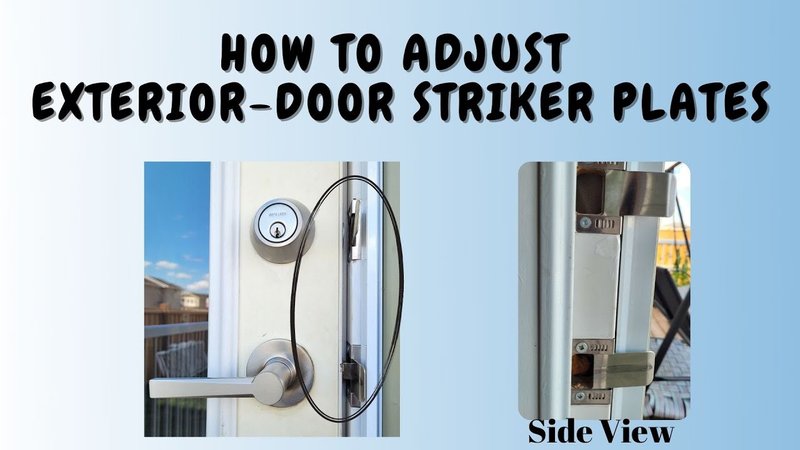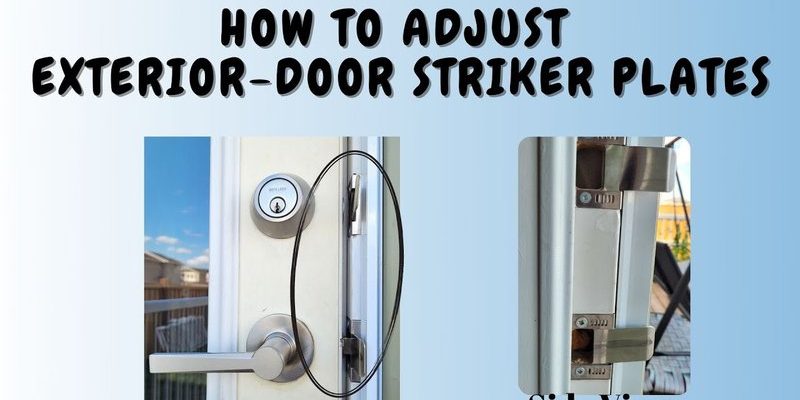
You might be thinking, “Isn’t a strike plate just a flat piece of metal?” Kind of, but it does a lot. Adjusting it right can make an old door feel new again. The process does take a bit of patience and some basic tools, but you won’t need fancy equipment or pro-level skills. Whether your house has a trusty Schlage, Kwikset, or a universal deadbolt, the technique is pretty much the same. Let me walk you through the steps, explain why each matters, and help you get that snug, secure fit you’re after.
Why Your Deadbolt Strike Plate Matters More Than You Think
Let me explain why fussing with a strike plate is worth your time. The strike plate is what the deadbolt actually slides into. When it’s lined up well, it holds the bolt *firmly*. If it’s off by even a few millimeters, your deadbolt might barely catch, causing it to rattle or fail completely. You might notice the door moves even when “locked”—that’s not just annoying, it’s a weak spot in your home’s defenses.
You might be wondering, “Can’t I just tighten the screws?” Sometimes, yes—but often, the real fix involves moving or deepening the plate, or even shimming it. Many homeowners think a loose fit means the lock is broken, but honestly, the strike plate is more often the culprit. This tiny piece of metal can make or break your home’s security.
A tight-fitting strike plate also keeps your door weatherproof. Gaps around the deadbolt can let in cold air, water, and even bugs. So, adjusting your plate isn’t just about stopping that irritating rattle—it’s also about comfort and saving energy. It’s a classic case of “small change, big difference.”
Signs Your Deadbolt Strike Plate Needs Adjustment
How do you know if your deadbolt strike plate is to blame for that loose fit? Here’s what to look for:
- The deadbolt feels loose or wiggles, even when locked.
- You have to push, pull, or slam the door for the deadbolt to “catch.”
- There’s a visible gap between the door and the frame when the lock is engaged.
- The bolt doesn’t slide easily into the plate, or you hear scraping or grinding.
If you’ve ever found yourself standing outside, jiggling your key and cursing under your breath, you know how frustrating this can be. I’ve also seen doors that look closed from the outside, but a gentle push swings them wide open—even with the deadbolt turned. That’s a clear sign the bolt isn’t actually engaging the strike plate, leaving your home unsecured.
You might even notice issues with smart locks or electronic deadbolts (like the August, Schlage Encode, or Kwikset Halo). These can have trouble syncing or locking if the bolt can’t fully extend. In other words, a misaligned strike plate can create headaches for both old-school and modern lock setups.
Tools and Materials You’ll Need
Before you start, you’ll want to gather a few basic items. Don’t worry—no special locksmith kit needed. Here’s the core lineup:
- Screwdriver (typically Phillips head)
- Chisel (for deepening the mortise if needed)
- Hammer or mallet
- Wood filler or toothpicks (for filling old screw holes)
- New screws (sometimes longer than the originals for a tighter hold)
- Utility knife (for fine adjustments)
- Pencil (for marking positions)
- Measuring tape or ruler
- Shims or thin cardboard (optional, for minor tweaks)
If you’re dealing with a universal deadbolt or a specific brand like Schlage or Kwikset, check if you have any unique screws or plates. Some locks come with their own hardware. For most jobs, though, the basics above will do the trick. Just make sure your screwdriver matches your screws—you don’t want to strip them accidentally.
How To Adjust a Deadbolt Strike Plate for a Tighter Fit: Step-by-Step Guide
Ready to dive in? Here’s the step-by-step process to adjust your deadbolt strike plate to get that tight, no-nonsense fit.
1. Check the Alignment
First, close your door gently and try turning the deadbolt. Watch and feel for resistance or looseness. Is the bolt going all the way into the strike plate? Or is it just barely catching? Mark where the bolt makes contact with the strike plate using a pencil—this helps you see exactly where adjustments are needed.
2. Remove the Strike Plate
Use your screwdriver to unscrew the strike plate from the door frame. Keep the screws handy—you’ll probably reuse them (unless they’re stripped or rusty). Inspect the area behind the plate for old screw holes or wood damage.
3. Adjust the Plate Position
If the bolt isn’t lining up with the hole in the plate, you’ll need to move it slightly. Here’s where a pencil and measuring tape come in handy. Mark the new spot on the frame where the plate should sit for a snug fit. If you need to move the plate more than about 1/8 inch, you may have to chisel the mortise (the recess in the wood) a bit deeper or wider. Go slowly—remove just enough wood to fit the plate flush.
4. Fill Old Screw Holes
If you’re shifting the plate, fill in the old screw holes with wood filler or push in some toothpicks and glue. This helps the new screws grip better and gives a stronger hold.
5. Reattach the Plate
Position the strike plate in its new spot, and screw it down firmly. Use longer screws if you want extra holding power or if the old holes were wobbly. Test the deadbolt—does it engage smoothly, without rattling or sticking? If yes, you’re golden.
6. Fine-Tune the Fit
Still a little loose? Sometimes, you can shim behind the strike plate with thin cardboard or a metal shim. This tightens things up without major carpentry. For a too-tight fit, use a utility knife to trim the plate opening ever so slightly.
Common Problems and Troubleshooting Tips
Honestly, things don’t always go perfectly on the first try. Maybe your plate is rusted, or the door frame wood has gotten soft. Here are some common bumps in the road, plus how to get past them:
- Problem: Bolt still doesn’t fit smoothly. Fix: Double-check alignment. Sometimes it’s the bolt that’s crooked, not just the plate. Try loosening the lock’s mounting screws and adjusting its angle.
- Problem: Screws won’t hold firm. Fix: Use longer screws, or fill old holes with wood filler or glue-soaked toothpicks before retrying.
- Problem: Plate opening is too tight. Fix: Carefully file or expand the hole using a utility knife or small file. Go slow—a little goes a long way.
- Problem: Door frame is cracked. Fix: Reinforce with wood glue, clamps, and—if needed—cover the damaged section with a larger strike plate for more coverage.
You might be tempted to force the bolt or just live with a sloppy lock, but honestly, it’s worth the extra few minutes to do things right. The tighter your strike plate fits, the better your door will resist forced entry and the less hassle you’ll have with sticking locks, syncing issues on smart locks, or deadbolt resets.
When To Consider a Universal Strike Plate or Brand-Specific Upgrade
You might be wondering if you need a universal strike plate or should stick with your current brand, like Schlage or Kwikset. Here’s my take: if your door frame is heavily worn, or the mortise is chewed up from multiple past adjustments, a universal plate can be a lifesaver. These plates are designed to cover bigger gaps and give extra support.
On the other hand, brand-specific plates (like those from Schlage, Kwikset, or Yale) sometimes have features that play well with their own locks—unique shapes, reinforced metal, or extra-long screws. If you have a high-security or smart deadbolt, staying brand-specific can help avoid sync or alignment headaches.
But honestly, for most standard doors, a universal strike plate is just fine and can be easier to install if you need to cover up old damage. Whichever you choose, the process for adjusting the deadbolt strike plate for a tighter fit stays the same—just make sure the bolt seats snugly and everything lines up cleanly.
The Payoff: Why a Tight Deadbolt Strike Plate Makes All the Difference
After all this, you might be wondering if it’s worth the effort. Here’s why it absolutely is. A tight-fitting deadbolt strike plate gives your lock real strength. The solid “clunk” when you lock up isn’t just satisfying—it means the bolt is fully engaged, making it much harder for someone to break in or for the wind to rattle your door free. Your heating and cooling bills might even get a little lower, since you’re sealing out drafts.
And here’s an unexpected bonus: doors with snug strike plates feel better to use. Little things, like not having to jiggle the key, or your smart lock syncing smoothly every time, make your home feel less fussy and more secure. It’s one of those upgrades you notice every time you leave or come home.
If you’ve ever struggled with a door that feels “off”—maybe the deadbolt keeps getting stuck, or the lock never seems quite right—taking the time to adjust the strike plate can solve problems you didn’t even realize had a solution.
A tight deadbolt strike plate is the secret ingredient for a door that locks up like new—quiet, reliable, and secure.
Final Thoughts: Take a Few Minutes, Get Years of Security
Here’s the thing: adjusting a deadbolt strike plate for a tighter fit isn’t the flashiest DIY job, but it pays off every single time you close your door. You don’t need special tools or a bunch of experience—just some patience and a willingness to try, whether your lock is a universal fit or a name brand like Schlage, Kwikset, or Yale. With a few careful tweaks, your door will fit better, your lock will work smoother, and your home will feel more secure. So grab your screwdriver, take it step by step, and enjoy that solid, confident “click” every time you lock up.
